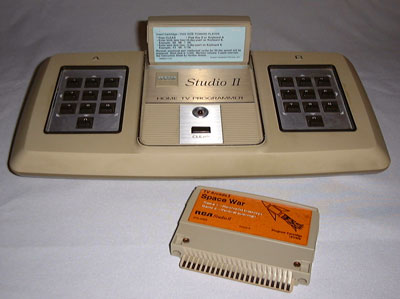
 |
Search | FAQ | US Titles | UK Titles | Memories | VaporWare | Digest | |||||||
| GuestBook | Classified | Chat | Products | Featured | Technical | Museum | ||||||||
| Downloads | Production | Fanfares | Music | Misc | Related | Contact | ||||||||
| CED in the History of Media Technology | ||||||||||||||

The RCA Studio II was designed in 1976, just after the Fairchild Channel F, but RCA didn't get it on the market until January 1977, thus being beaten by Fairchild. Indeed, it is strange that this was the second system with interchangeable ROM cartridges to appear, as it's inferior to the Fairchild Channel F in some important ways. The graphics are in monochrome (Fairchild had color) and the controllers are keypads built into the base unit (the Fairchild had corded joysticks). With these deficiencies, the Studio II was a poorer seller than the Fairchild Channel F, even with RCA's great marketing strengths, and the system was withdrawn in 1979.
The heart of the Studio II was RCA's COSMAC microprocessor, which was about equal in performance to the F8 processor used in the Fairchild Channel F. You might wonder why RCA used an instruction-set clone of the F8 in their first generation CED players when the in-house COSMAC processor was available. Well, the SFT100 didn't come out until 1981, and by that time both the original F8 and COSMAC were outdated from the viewpoint of inexpensive mass production. These original chips would have required considerable support circuitry for the 2000 bytes of object code used for the SFT100 system control. The Mostek 3870 which ran the same object code as the F8 was a later design that had 2KB of ROM inside the processor package itself, making for a simpler and less expensive design. RCA never produced a COSMAC processor with an integral ROM. But from a modern perspective, CED player maintenance would be easier if RCA had used the COSMAC, as the external ROM could be replaced separately from the processor, and the COSMAC is one of the few 8-bit microprocessors that continues to be manufactured (as the Intersil CPD1802). Thomson brought out Mostek Corporation, ironically at nearly the same time they brought the RCA Consumer Electronics Division, and the Mostek 3870 microprocessor is long gone.
An interesting side note on the RCA COSMAC processor is that it now has the distinction of being the furthest microprocessor from Earth. NASA chose it as the processor for the computers in the Voyager spacecraft, which were launched in 1977 along with the Voyager Interstellar Record. The original COSMAC was appealing because of its Silicon On Sapphire (SOS) construction which imparted greater resistance to the radiation encountered in space. The record for the most distant microprocessor was held for many years by the Intel 4004 (the original 4-bit processor from 1971) in the Pioneer 10 spacecraft launched in 1972. But the Voyager 1 is traveling faster than Pioneer 10 and is now over 7 billion miles from the sun (and still working).